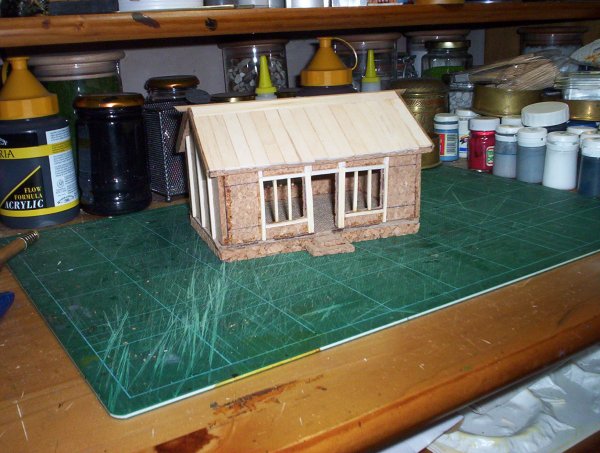|
Making a Chinese house from cork board
The walls are cut from 3.2mm cork tile using the Stanley knife. The long walls are 143mm x 40mm (to allow the short walls to stand outside them and still fit on the base) and the short ones are 100mm x 70mm. These are cut to a point for the roof. To do this, measure each outside edge from the base up to 40mm and mark them. Then, find and mark the mid point along the top edge of the wall, it will be at the 50mm point. Draw a line from each side mark to the top centre mark and this will give you your lines to cut to. Cut out windows and doors. The doors are 20mm wide and 40mm tall. The windows are 30mm x 30mm. There is 10mm between the windows and the wall top and bottom. And a 5mm gap between the windows and the door between them. The wooden beams are made from match sticks and balsa wood strip for the long bits. The window struts are secured with superglue, everything else is held together with white glue. The base is cut from 9mm cork tile and faced with hardboard. This is a different type of cork to the thin stuff and is sold as ‘wall cork’ or ‘noticeboard cork’, it has a much more open texture than the thin cork but is just as resilient. I use it where I need a visible wall thickness or (as here) where I want the texture to represent rock or rough stone. The base measures 150mm x 100mm. The walls are glued to each other and the base using superglue. The roof is made from two rectangles of 3.2mm cork, each measuring 65mm x 165mm. Planks made from ice lolly sticks (tongue depressors?) are glued to these with white glue. Lolly sticks are cheaper than modelling wood and are pre-sanded smooth because they're designed to go into mouths. Some of my buildings have a narrow tiled effect which is done with cocktail sticks. Single ended are best, glue them on allowing the pointed ends to overhang and saw all these off together once the glue has dried. The two roof halves are held together by a hinge made from masking tape and braced with triangles of cork. Modelling wood is used to cap the ends of the roof and a piece of dowel is glued in the centre to fill the gap and add decoration. The dowel is cut at an angle of 45 degrees to add more of an oriental look. Add a front step from cork off-cuts and you're ready to paint. |












